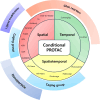Conditional PROTAC: Recent Strategies for Modulating Targeted Protein Degradation
- PMID: 38993102
- PMCID: PMC11581424
- DOI: 10.1002/cmdc.202400326
Conditional PROTAC: Recent Strategies for Modulating Targeted Protein Degradation
Abstract
Proteolysis-targeting chimeras (PROTACs) have emerged as a promising technology for inducing targeted protein degradation by leveraging the intrinsic ubiquitin-proteasome system (UPS). While the potential druggability of PROTACs toward undruggable proteins has accelerated their rapid development and the wide-range of applications across diverse disease contexts, off-tissue effects and side-effects of PROTACs have recently received attentions to improve their efficacy. To address these issues, spatial or temporal target protein degradation by PROTACs has been spotlighted. In this review, we explore chemical strategies for modulating protein degradation in a cell type-specific (spatio-) and time-specific (temporal-) manner, thereby offering insights for expanding PROTAC applications to overcome the current limitations of target protein degradation strategy.
Keywords: PROTAC; Spatial PROTAC; Spatiotemporal PROTAC; Targeted Protein Degradation (TPD); Temporal PROTAC.
© 2024 The Author(s). ChemMedChem published by Wiley-VCH GmbH.
Conflict of interest statement
The authors declare no conflict of interest.
Figures




Similar articles
-
Strategies for Precise Modulation of Protein Degradation.Acc Chem Res. 2025 Apr 15;58(8):1236-1248. doi: 10.1021/acs.accounts.5c00003. Epub 2025 Mar 25. Acc Chem Res. 2025. PMID: 40132213 Review.
-
PROTAC 2.0: Expanding the frontiers of targeted protein degradation.Drug Discov Today. 2025 Jun;30(6):104376. doi: 10.1016/j.drudis.2025.104376. Epub 2025 May 8. Drug Discov Today. 2025. PMID: 40348076 Review.
-
Precise Modulation of Protein Degradation by Smart PROTACs.Chembiochem. 2025 Jan 2;26(1):e202400682. doi: 10.1002/cbic.202400682. Epub 2024 Nov 11. Chembiochem. 2025. PMID: 39367518 Review.
-
Delivering on Cell-Selective Protein Degradation Using Chemically Tailored PROTACs.Chembiochem. 2023 Oct 4;24(19):e202300413. doi: 10.1002/cbic.202300413. Epub 2023 Aug 7. Chembiochem. 2023. PMID: 37496112 Review.
-
PROTACs: An Emerging Therapeutic Modality in Precision Medicine.Cell Chem Biol. 2020 Aug 20;27(8):998-1014. doi: 10.1016/j.chembiol.2020.07.020. Epub 2020 Aug 13. Cell Chem Biol. 2020. PMID: 32795419 Free PMC article. Review.
Cited by
-
Precision-engineered PROTACs minimize off-tissue effects in cancer therapy.Front Mol Biosci. 2024 Nov 22;11:1505255. doi: 10.3389/fmolb.2024.1505255. eCollection 2024. Front Mol Biosci. 2024. PMID: 39649701 Free PMC article. Review.
-
Current trends in theranostic applications of extracellular vesicles in cancer.Front Oncol. 2025 Jun 3;15:1592006. doi: 10.3389/fonc.2025.1592006. eCollection 2025. Front Oncol. 2025. PMID: 40530018 Free PMC article. Review.
References
-
- Bett J. S., Essays Biochem. 2016, 60(2), 143–151. - PubMed
Publication types
MeSH terms
Substances
Grants and funding
- RS-2023-00250887/National Research Foundation of Korea funded by the Ministry of Science, ICT & Future Planning
- 2023R1A2C1007899/National Research Foundation of Korea funded by the Ministry of Science, ICT & Future Planning
- 2021R1C1C1005766/National Research Foundation of Korea funded by the Ministry of Science, ICT & Future Planning
- 2022R1C1C2008563/National Research Foundation of Korea funded by the Ministry of Science, ICT & Future Planning
- RS-2023-00271205/National Research Foundation of Korea funded by the Ministry of Science, ICT & Future Planning
LinkOut - more resources
Full Text Sources

